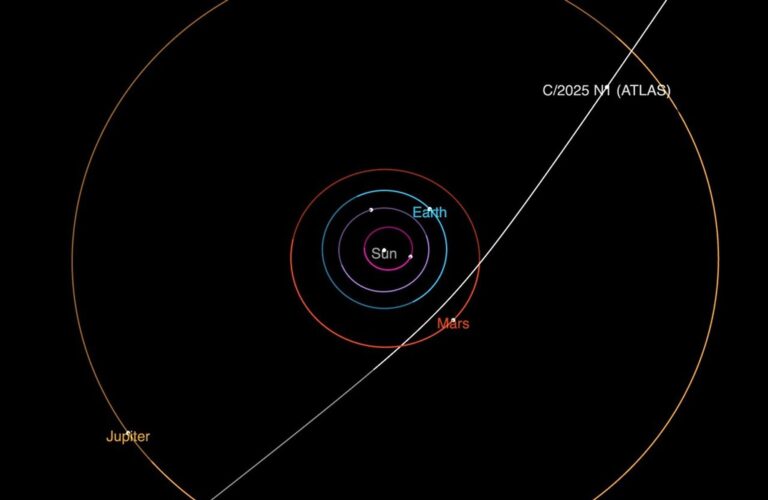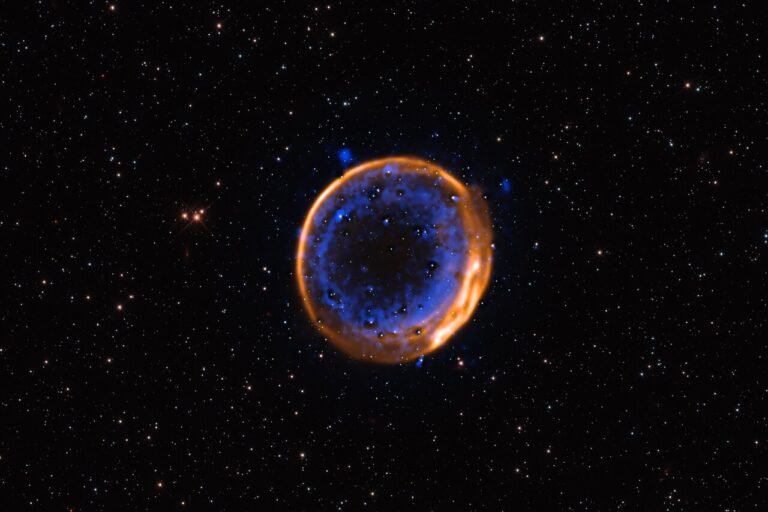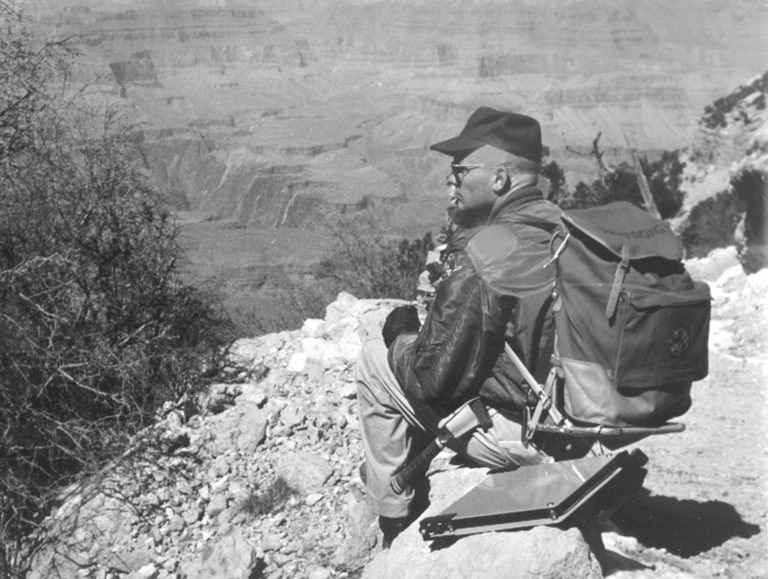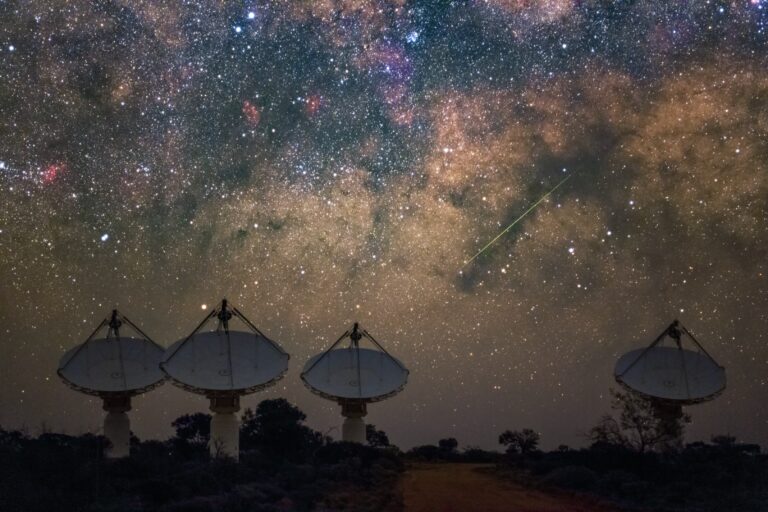
Key Takeaways:

Jupiter’s dynamic cloud tops are a treat to view through any telescope, particularly in the few weeks surrounding its December 2 opposition. // NASA/JPL/University of Arizona
This year’s winter sky holds many planetary treats. Jupiter reaches its yearly peak in December and dominates the sky all night. The morning sky, on the other hand, offers some superb views from Mercury, Venus, Saturn, and a crescent Moon. Spectacular Geminid meteors punctuate the overnight hours in mid-December. The shower’s high hourly rates and the Moon’s absence make this one of the year’s best.
Our planetary tour begins low in the southwestern sky after sunset. Mars glimmers at magnitude 1.2 all month and is easy to see in late twilight if you have a clear and unobstructed horizon. If you target the Red Planet through 7×50 binoculars December 1, you also might glimpse the faint fuzzy impression of globular cluster M22, which lies 3° west of Earth’s neighbor. This fine globular will be a challenge to see against the twilight glow.
As the month progresses, M22 and its host constellation, Sagittarius the Archer, succumb to the Sun’s glow. Mars, however, moves eastward quickly relative to the background stars and thus remains in a holding pattern relative to the Sun. The planet maintains roughly the same altitude every night and sets about two hours after our star all month.
A waxing crescent Moon joins Mars in mid-December. On the 14th, it lies to the planet’s right; the next evening, our satellite stands directly above Mars. The planet crosses from Sagittarius into Capricornus on December 25 in a valiant attempt to avoid the Sun’s relentless pursuit. It won’t lose the race until early February. When viewed through a telescope, Mars shows no detail on its 4″-diameter disk.
You can spot Neptune through binoculars if you have a steady hand or, even better, a tripod. The most distant major planet lies high in the south right after nightfall. It glows at magnitude 7.9, 10 times dimmer than its neighbor, the magnitude 5.4 star 38 Aquarii. Neptune passes 0.35° due south of this star December 6 and remains within 0.5° of it all month. You’ll want to search for Neptune early in the evening because it sets by 10 p.m. local time at midmonth.
These chilly winter evenings are a great time to track down Uranus. Finding the planet’s location is a snap. Simply draw an imaginary line between the stars Alpheratz and Algenib — those that mark the eastern (left) side of the Great Square of Pegasus — and continue the same distance farther south. You’ll see a compact parallelogram of four 6th- and 7th-magnitude stars at this spot; Uranus lies just south of this group and shines a little brighter than any of them.
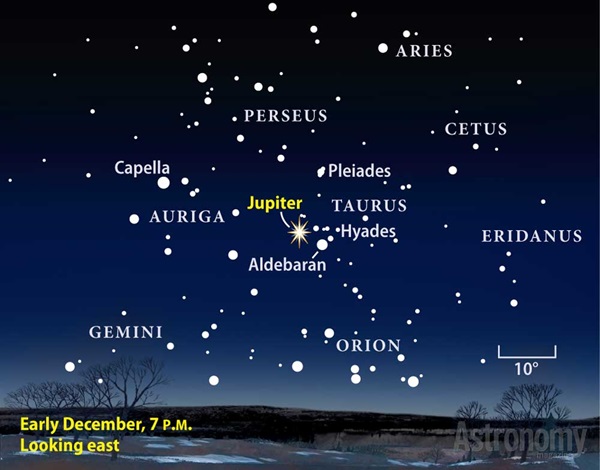
Look for Jupiter as it climbs the eastern sky in the early evening. The giant planet currently resides near the center of the constellation Taurus. // Astronomy: Roen Kelly
Glowing at magnitude 5.8, the planet shows up nicely through binoculars and even appears to naked eyes under a dark sky. A telescope reveals its 3.6″-diameter disk and distinctive blue-green color.
British astronomer and musician William Herschel discovered Uranus in 1781, but the planet held its secrets until the Voyager 2 spacecraft flew by in January 1986. Today, only the Hubble Space Telescope and large ground-based instruments viewing in the infrared can record appreciable details in the planet’s cloud tops. Yet amateurs who record video of Uranus and stack the best frames are pushing back the envelope of what is possible. The distant world’s high altitude in early evening makes this a good month to experiment with imaging.
Jupiter rises opposite the setting Sun as the month begins. The brilliant orb appears conspicuous above the eastern horizon soon after sunset. As the sky darkens, the star-studded backdrop of Taurus the Bull comes into view. On December 7, the planet passes 5° due north of 1st-magnitude Aldebaran, Taurus’ orange-colored luminary. But the brilliant planet shines at magnitude –2.8, some 30 times brighter than the star. Jupiter’s slow westward motion relative to the starry background carries it just north of the prominent Hyades star cluster later in the month.
Although peak visibility arrives at opposition December 2, Jupiter remains a stunning sight all month. For Northern Hemisphere observers who view the giant world through a telescope, this year’s opposition is one of the best. From midnorthern latitudes, Jupiter stands about 70° above the southern horizon around local midnight. The high altitude minimizes the amount of atmosphere the planet’s light traverses on its way to Earth’s surface and sharpens images in the eyepiece.
With a disk that spans up to 48″, the giant planet lives up to its name this month. The large diameter provides the best views of any planetary surface or atmosphere. Take your time at the scope — your patience will be rewarded.
Jupiter sports two parallel dark belts that straddle the equator. They are the most obvious features in the planet’s massive atmosphere, although other dark belts and lighter zones show up as your eyes adapt to the sight. These lower-contrast features pop into view during moments of good seeing.
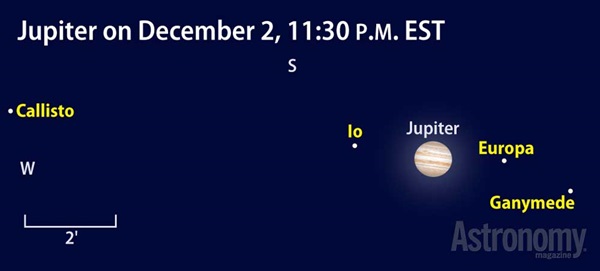
Jupiter’s four bright moons array on either side of the giant planet’s disk the night it reaches opposition. // Astronomy: Roen Kelly
As you gaze at Jupiter through your telescope, you can’t miss its four planet-sized satellites: Io, Europa, Ganymede, and Callisto. They orbit the giant world with periods that range from less than two days (Io) to more than two weeks (Callisto).
Prior to Jupiter’s opposition, the shadows of the inner three moons transit the planet’s disk before the moons themselves. After opposition, each shadow trails its associated moon. These events vividly illustrate the geometry of the jovian satellite system. And with December’s long nights, plenty of them take place with the planet high in the sky.
On December 7/8, Io starts transiting Jupiter at 12:09 a.m. EST, and its shadow follows eight minutes after. An hour later, Io and its nearby black shadow appear midway across the jovian disk. Io leaves Jupiter behind at 2:19 a.m., with its shadow trailing nine minutes behind.
Ganymede, the solar system’s largest satellite, moves more slowly because it orbits farther from Jupiter. On December 12/13, this moon transits the planet’s south polar region starting at 12:39 a.m. EST, and its shadow follows nearly an hour later, at 1:37 a.m. The transit concludes at 2:33 a.m. while the shadow lifts back into space at 3:45 a.m. Ganymede takes less time than Io to transit because it has less distance to cover near the planet’s south pole.
Europa orbits between Io and Ganymede. A nicely timed transit of this moon starts at 12:01 a.m. EST the night of December 27/28. The shadow first appears at 1:16 a.m. The moon itself leaves the disk at 2:23 a.m., with the shadow following at 3:40 a.m.
As Jupiter dips low in the northwest before dawn, the southeastern sky erupts with planet activity. Saturn, Venus, and Mercury form a tight group in early December that widens slowly as the month advances. On the 1st, the conspicuous trio spans 13° under a fairly dark sky. Saturn rises nearly three hours before the Sun. Shining at magnitude 0.7, it’s the faintest of the three. Venus comes up about 25 minutes later and blazes at magnitude –3.9, easily outperforming the other two. Mercury rises 40 minutes after its brighter neighbor and glows respectably at magnitude –0.3.

Saturn, Venus, and Mercury lie near each other this month. They appear most striking when the Moon passes by on the 11th. // Astronomy: Roen Kelly
While Saturn’s elongation from the Sun increases, the two inner planets spend most of December drawing closer to our star. On the 10th, when a waning crescent Moon passes 4° south of Saturn, the ringed planet lies 15° from Venus. By the following morning, the thinning lunar crescent drops to within 2° of Venus to create a dramatic scene before dawn. Mercury, which by then has brightened to magnitude –0.5, stands 6° east of Venus.
Saturn continues to improve with each passing day. On the 31st, it rises nearly five hours before the Sun. A telescope will provide early risers with jaw-dropping views. Saturn’s disk measures 16″ across while the ring system spans 37″ and tilts 19° to our line of sight. This is as open as the planet’s rings have appeared since 2006, which makes their structure significantly easier to discern.
Mercury reaches greatest elongation December 4, when it lies 21° west of the Sun and rises almost two hours before our star. Its 7″-diameter disk then appears 61 percent lit. The innermost planet approaches closest to Venus on December 9, when they lie 6° apart. Both planets show fatter phases as the month wears on, with Mercury at 74 percent lit and Venus at 90 percent illumination on the 9th.
Mercury’s eastward motion relative to the stars carries it to a point 6° north of 1st-magnitude Antares in Scorpius on December 17. You’ll likely need binoculars to spot the star against the twilight background. Venus follows suit six days later, when it passes a similar distance north of Antares.
Mercury continues to descend into brighter twilight, and by Christmas morning it rises only an hour before the Sun. Just a week later, that time has been cut nearly in half. Venus lingers a while longer, rising 90 minutes before sunrise on the year’s final morning.
Earth’s winter solstice arrives at 6:12 a.m. EST on December 21. This marks the moment when the Sun lies farthest south in the sky and appears lowest at local noon for Northern Hemisphere observers.
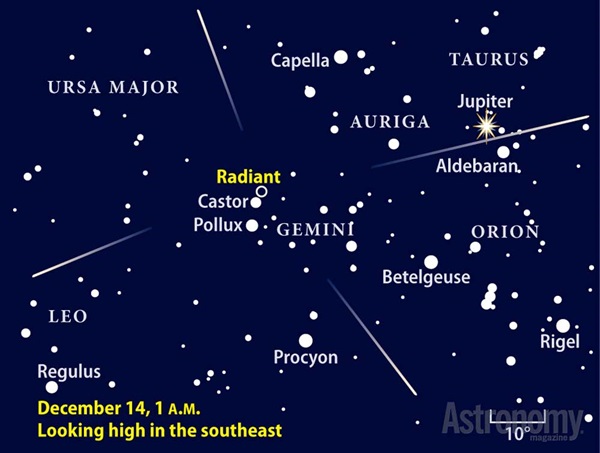
The Geminid meteor shower peaks the night of December 13/14, when observers could see up to 120 meteors per hour. // Astronomy: Roen Kelly
The Twins unleash a shooting-star torrent
The Geminid meteor shower ranks among the year’s finest. At its peak the night of December 13/14, it should produce somewhere between 80 and 120 meteors per hour under optimal conditions. And with New Moon arriving early on the 13th, celestial conditions couldn’t be better. If the weather cooperates, we should be in for a memorable show.
The shower’s radiant — the point from which the “shooting stars” appear to emanate — lies just north of the bright star Castor in the constellation Gemini the Twins. This area climbs nearly overhead around midnight but remains high for a few hours on either side. The best meteor watching will come from rural areas with no interference from streetlights, security lights, or other artificial illumination. The shower remains active December 4 to 17.
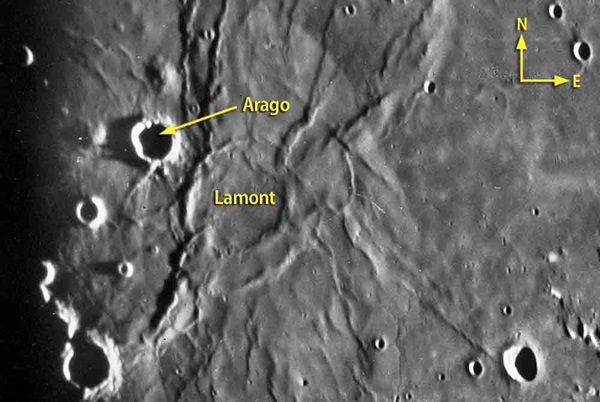
Arago and ghostly Lamont look spectacular at low Sun angles. Good views will come the evening of December 18. // Consolidated Lunar Atlas/UA/LPL
A ghostly ring haunts the Sea of Tranquility
The waxing crescent Moon is always a crowd-pleaser. On the evening of December 18, a day before First Quarter phase, the alluring spread of craters in the Moon’s southern hemisphere gives way to wrinkled ridges crossing the dark lava seas to the north. Pry your eye from the lovely Serpentine Ridge in Mare Serenitatis (the Sea of Serenity) and settle on a spot just north of the equator where several lunar ridges ply the frozen face of Mare Tranquillitatis (the Sea of Tranquility).
Literally buried under this mare’s mostly north-south ridges is a ghostly ring named Lamont. Astronomers think this circular feature is all that remains of an impact basin subsequently flooded to the rim by upwelling lava. A second concentric ring, about twice Lamont’s size, is trickier to see. Multiple rings are a fairly common feature of large basins.
Long after Lamont formed, a smaller impactor carved out the crater Arago to the northwest. Just north of Arago is a modest bump that represents the largest of a family of volcanic domes in this neighborhood. Both the wrinkles and the domes have such gentle slopes that they disappear by the 19th under the higher Sun angle.
Meanwhile, if you like to watch lunar scenery change and you have clear skies for a few nights in a row, note how Mare Australe near the Moon’s southeastern limb rolls out of view. As the Moon drops below the plane of Earth’s orbit around the Sun (the ecliptic), we see less of the southern areas and more of the northern ones.
| When to view the planets | ||
| EVENING SKY | MIDNIGHT | MORNING SKY |
| Mars (southwest) | Jupiter (southwest) | Mercury (southeast) |
| Jupiter (east) | Uranus (west) | Venus (southeast) |
| Uranus (southeast) | Jupiter (northwest) | |
| Neptune (south) | Saturn (southeast) | |

Comet C/2012 KS (LINEAR) tracks near the Big Dipper’s handle and the Whirlpool Galaxy (M51) during December. // Astronomy: Roen Kelly
Whirling through the Great Bear
Eighteenth-century French comet hunter Charles Messier compiled a famous catalog of objects that looked like comets. His purpose: to help his fellow sleuths so they wouldn’t mistake these deep-sky imposters for the real thing. This month, you have a great opportunity to compare a comet with one of Messier’s deep-sky discoveries.
Comet C/2012 K5 (LINEAR) passes within a few degrees of the magnificent Whirlpool Galaxy (M51) in Canes Venatici during December’s second week. Astronomers expect the comet to glow around 10th or 11th magnitude, which puts it more in line with M51’s interacting companion, NGC 5195.
You can locate the comet via a short star-hop from either M51 or one of the three suns in the Big Dipper’s handle. The comet passes less than 1° from Eta (η) Ursae Majoris on December 8, 2° from Zeta (ζ) UMa on the 14th, and less than 1° from Epsilon (ε) UMa on the 16th.
Once you’ve found the comet at low power, increase the magnification to take a closer look. The comet’s surface is hidden from view by a thick shroud of dust aptly named the false nucleus. This feature appears stellar within a roundish diffuse glow. Now hop over to M51’s companion and contrast its circular glow with the comet’s core. NGC 5195’s center should appear bigger and brighter.
Although technically visible all night due to its far-northern location, the comet appears better after midnight once Ursa Major climbs higher. And you’re better off observing in December’s middle two weeks when moonlight won’t wash away its diffuse glow.
This comet saved us just in time. Observers depend on the distant Oort Cloud to supply nice targets while we wait for short-period comets like 2P/Encke to return. C/2012 K5 spared us from a three-month drought until the potentially naked-eye Comet C/2011 L4 (PanSTARRS) vaults into March’s evening sky.

Asteroids Ceres and Vesta appear against the backdrop of Taurus this month and will be easy to spot through binoculars. // Astronomy: Roen Kelly
Ceres and Vesta steer onto the Bull’s head
Two main-belt asteroids come within easy reach of binoculars this month. Both 1 Ceres and 4 Vesta reside among the background stars of Taurus the Bull. The ruddy 1st-magnitude star Aldebaran (which marks the Bull’s eye) and 2nd-magnitude Beta (β) Tauri (one of the animal’s horns) will get you to the right spots.
Both asteroids reach opposition this month. Vesta achieves this milestone first, on the night of December 8/9, when it glows at magnitude 6.4. Ceres follows on the 18th, when it peaks at magnitude 6.7. At opposition, a solar system object remains visible all night and appears highest around local midnight.
The two asteroids are among the more conspicuous objects in this part of the sky. A handful of brighter suns makes it easy to track the minor planets. Simply look for a pattern that changes from night to night — Ceres and Vesta will be the odd men out.
Ceres spans about 590 miles while Vesta measures 355 miles across. Astronomers know a lot more about Vesta because NASA’s Dawn spacecraft recently completed a reconnaissance of the asteroid. It’s shaped like an out-of-round potato, sports a huge crater with a giant central peak at its south pole, and has a series of parallel grooves near its equator. Does Ceres show a similarly bizarre surface? We won’t know until Dawn arrives there in 2015.
Martin Ratcliffe provides professional planetarium development for Sky-Skan, Inc. Alister Ling is a meterologist for Environment Canada.






